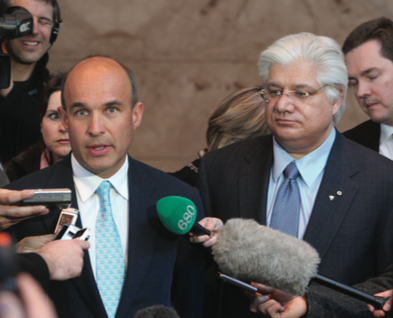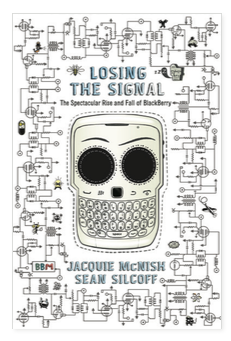Short-Circuited

Sean Silcoff, BCom’92, has co-authored Losing the Signal: The Spectacular Rise and Fall of BlackBerry with fellow Globe and Mail reporter Jacquie McNish. Their book, released in May, relates the story of the iconic company that created an addictive smartphone, which generated nearly $20 billion in annual revenue at its peak. The authors tell the story of how Jim Balsillie and Mike Lazaridis, the company’s two mismatched CEOs, outsmarted more powerful competitors with a combination of innovation and sharp-elbowed tactics; and how, once on top of the world, they lost their way.
In the following excerpt from Chapter 13, the authors delve behind-the- scenes into the problems that plagued the launch of the BlackBerry Storm in late 2008. This new release was the company’s first smartphone with a touch-screen rather than physical keyboard. Designed to compete head-to-head with the iPhone, Storm was initially embraced by Verizon, one of the largest cellphone carriers in the U.S. But the glitch-plagued initial release cost Verizon dearly, with mounting product returns and negative publicity. Verizon claimed it was payback time, to the tune of $500 million, while BlackBerry executives scrambled to fix the problems.
Chapter 13 – Disconnect
Jim Balsillie wasn’t going to waste a minute of the short flight to New Jersey aboard RIM’s Dassault Falcon 900 jet. The RIM chief had been summoned to Verizon Wireless headquarters in Basking Ridge, and as they sat in their boardroom in the sky, Balsillie led a team of RIM sales executives one last time through the possible scenarios that lay ahead. Mike Lazaridis was not along for the ride. The man who had sold Verizon on Storm had turned down his partner’s invitation to face the carrier alongside him.
It was spring 2009, and the Storm’s initial success was now a distant memory. “It was the best-selling initial product we ever had,” says Lazaridis, with one million devices sold in the first two months. “We couldn’t meet demand.” But as Verizon customers—many of them first-time BlackBerry buyers—began using the Storm, something didn’t seem right. The browser was painfully slow. The clickable screen didn’t respond well in the corners and the device often froze and reset. BlackBerry devotees who tried Storm found it awkward and slow typing with one big button, rather than a physical keyboard. The reviewers had been right. “The thing was a mess,” says Jon Rettinger of the consumer gadget review site TechnoBuffalo. Rettinger was one of the first people to get his hands on the device before it was released to the public. “It was fine for phone calls, but unusable for any sort of input at all.” Customers flooded back to stores dissatisfied with their touch-screen BlackBerrys.
Balsillie knew returns were high. What he didn’t realize was how severe the problem was. As their meeting got under way, Verizon’s chief marketing officer, John Stratton, laid out the shocking news to his guests from Waterloo. Virtually every one of the first batch of about one million Storms shipped needed replacing. Many of the replacements were being returned as well. The Storm was a complete failure, and he wanted RIM to pay. “You’re going to make us whole on the money we’ve spent fixing your Storm product problems,” Stratton told Balsillie, “or we’ll revisit our whole supplier relationship with you. This is your responsibility. We expect you to step up because this is your fault, not ours.” Verizon wanted close to $500 million from RIM.
The options were dire. If Balsillie gave in, it would set a bad precedent and wipe out that quarter’s earnings. RIM would have a public relations fiasco on its hands, forced to reveal how poorly Storm had fared. RIM had worked hard to build its relationship with Verizon, but there was no certainty that caving would win him any favors with an unsatisfied customer.
“I can’t write a check like that,” Balsillie said. Instead, he and his team walked Stratton through the action plan they had rehearsed on the plane. Balsillie offered Stratton a range of concessions, including a free repair and upgrade program and a cache of complimentary BlackBerrys. The fix would cost RIM more than $100 million, but that would barely dent RIM’s income statement compared to the bath it would have to take to make Verizon whole.
 Research In Motion co-CEOs Jim Balsillie (left) and Mike Lazaridis talk to the media after an Ontario Securities Commission hearing in Toronto on Feb. 5, 2009. Stratton wasn’t happy, but he had little choice. Verizon had signed a “take-or-pay” deal, meaning it was stuck with the units it committed to buy. Stratton warned Balsillie this would dramatically change the carrier’s relationship with RIM. But Balsillie and sales vice president Craig McLennan, who attended the meeting, believed Verizon would forgive them. “RIM had faced challenging situations in the past and we’d always figured out a way to make it work,” says McLennan.
Research In Motion co-CEOs Jim Balsillie (left) and Mike Lazaridis talk to the media after an Ontario Securities Commission hearing in Toronto on Feb. 5, 2009. Stratton wasn’t happy, but he had little choice. Verizon had signed a “take-or-pay” deal, meaning it was stuck with the units it committed to buy. Stratton warned Balsillie this would dramatically change the carrier’s relationship with RIM. But Balsillie and sales vice president Craig McLennan, who attended the meeting, believed Verizon would forgive them. “RIM had faced challenging situations in the past and we’d always figured out a way to make it work,” says McLennan.
At first, that seemed to be the case. Verizon launched promotions to move more Storms through mid-2009 and committed to sell the sequel, Storm 2, that fall. But McLennan soon sensed something wasn’t right. Demand from Verizon for the Curve, another BlackBerry handset, fell significantly below expectations over the summer months and its commitment to Storm 2 was lukewarm. If the carrier was still looking for its Apple killer, McLennan could tell from the size of its order that Storm 2 wasn’t it. Whatever Verizon was planning to promote during the upcoming pre-Christmas marketing blitz that year, BlackBerry wouldn’t get the starring role. “We knew something was going on; we just didn’t know what or with whom,” says McLennan.
Storm’s failure was a rude awakening that resonated deeply within RIM. For the first time since it went public, RIM had delivered a product that widely missed the mark. Given the opportunity to vault past Apple and regain its lead in the smartphone race, RIM had fallen short. RIM was used to winning praise and adulation for its devices; now critics were questioning whether it could still innovate. “Everybody was upset. It was demoralizing for the whole organization,” says Don Morrison. “You’re shattering the very fabric of what BlackBerry stood for.” Larry Conlee, who accepts his part of the blame for Storm, says: “We thought it was within our ability to get it done. We were wrong. I think people were embarrassed.”
But Lazaridis didn’t treat Storm like a failed product. It was RIM’s first crack at a new technology. Sometimes, like with the Bullfrog and the Leapfrog a decade earlier, manufacturers needed a second try to get things right. When he looked at Storm, Lazaridis saw its technical achievements: it had a good camera, video streaming capabilities, a great speaker, and a replaceable battery. It was Verizon’s first 3G device. Most of all, he loved the clickable screen. Lazaridis hated the sensation of typing on glass, of using a touch-screen keyboard that didn’t physically respond to every click. He couldn’t fathom that consumers might not love his clickable screen—it had to be the fault of his staff for delivering a poorly built product. “We let Mike down, in his mind, because he made a request and we didn’t deliver,” says Morrison. “Whether the request is reasonable or not is not part of that sentence.” David Yach, Lazaridis’s chief technology officer in charge of software, shouldered much of the blame from Lazaridis for Storm’s shortcomings. “He would say, ‘You must have crappy people,’ ” Yach says. “He was clearly frustrated. From his perspective he felt that he was let down.”
If the smartphone world was shifting to touch, Lazaridis was convinced Storm was the kind of device BlackBerry should continue to make and one that consumers would embrace. RIM would try again with a clickable screen on Storm 2. Lazaridis believed it would succeed now that the bugs on the original Storm were fixed. Despite Storm’s dissatisfied customers, there was still huge consumer interest: one year after the Storm launch it ranked third only to the Pearl and iPhone in buyer intentions among prospective U.S. smartphone buyers, according to the market research firm comScore. But the improvements on Storm 2—including new technology that enhanced the click screen’s responsiveness—didn’t help: sales were tepid. It wasn’t until well into development of a third clickable touch-screen device for AT&T in early 2010 that Lazaridis abandoned the click feature altogether. That only happened after the carrier requested RIM drop the mechanical technology and just do a regular touch-screen, like its rivals.
Although the market rejected his initial touch-screen approach, Lazaridis believed the four pillars of BlackBerry’s success—good battery life, miserly use of carrier spectrum, security, and the ability to type—still applied in the new smartphone world and gave his company its competitive advantage. To him, those elements “made a BlackBerry a BlackBerry,” says one former top-level executive. Two years after Apple’s launch, it still amazed Lazaridis that iPhone users had to cart around adaptors to power up depleted batteries. His early prediction that Apple would cause AT&T headaches also proved right. By 2009, users of the network-hogging iPhone were squeezing the carrier to its capacity, reducing overall network reliability for all customers. Consumers took to social media to complain about the lousy service and Consumer Reports ranked AT&T worst for dropped calls. The mobile carrier’s CEO, Ralph de la Vega, further rankled customers by warning he would have to start jacking up prices or cap data use. AT&T hadn’t counted on the flood of data use that was overwhelming its network, and Apple’s unwillingness to help worsened relations between the two. While AT&T was activating millions of iPhones per quarter—drawing customers away from other carriers—and charging 1.6 times more than other subscribers, the huge subsidy it paid Apple to offset the cost of the iPhone cut deeply into its earnings.1
 The Spectacular Rise and Fall of BlackBerry by Jacquie McNish and Sean Silcoff © 2015. Published by HarperCollins Publishers Ltd. All rights reserved. But there was no going back. Apple may have broken the rules for smartphone makers, but it was setting the agenda for the wireless industry. RIM, like others, were now followers. “We built a perfectly evolved, optimized service and product offering that made the industry take off,” says Lazaridis. “There was a point where the carrier, by changing the rules, forced all the other carriers to change the rules eventually. It allowed Apple to reset what the expectations were. Conservation didn’t matter. Battery life didn’t matter. Cost didn’t matter. That’s their genius. We had to respond in a way that was completely different than what people expected.”
The Spectacular Rise and Fall of BlackBerry by Jacquie McNish and Sean Silcoff © 2015. Published by HarperCollins Publishers Ltd. All rights reserved. But there was no going back. Apple may have broken the rules for smartphone makers, but it was setting the agenda for the wireless industry. RIM, like others, were now followers. “We built a perfectly evolved, optimized service and product offering that made the industry take off,” says Lazaridis. “There was a point where the carrier, by changing the rules, forced all the other carriers to change the rules eventually. It allowed Apple to reset what the expectations were. Conservation didn’t matter. Battery life didn’t matter. Cost didn’t matter. That’s their genius. We had to respond in a way that was completely different than what people expected.”
By early 2009, Lazaridis decided the answer was to put a better Internet browser on the BlackBerry. He had long been frustrated that RIM’s browser was inferior to the one on his computer. Most websites were not built for mobile devices, so in the early days RIM had custom-built technology that grabbed data from the sites and filtered them into barebones versions of the pages for BlackBerry users—the “baby Internet,” as Steve Jobs had called it. Yach’s team had built a new browser for Bold and Storm that more closely resembled the iPhone’s browser, but it was often slow and awkward; pages didn’t fully display and were harder to navigate.
Lazaridis realized that to match Apple, RIM would have to base its next browser on the freely available technology called WebKit. It was commonly used on personal computers and rendered the best handheld surfing experience available, like the iPhone’s Safari browser. That summer, Lazaridis bought a Toronto start-up called Torch Mobile for $13.6 million. Torch had built WebKit browsers for Motorola, and Lazaridis was convinced it made the fastest mobile browser in the market. Now it was his.
1 Stephen H. Wildstrom, “How Apple’s iPhone Reshaped the Industry,” Bloomberg Businessweek Magazine, December 10, 2008.
Excerpt from: Losing the Signal: The Spectacular Rise and Fall of BlackBerry by Jacquie McNish and Sean Silcoff © 2015. Published by HarperCollins Publishers Ltd. All rights reserved.

